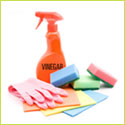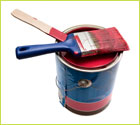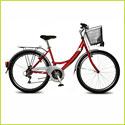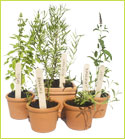With these 21 tips, you'll improve your health, help the earth, and save hundreds of dollars a year!
It's the simple truth—protecting the environment helps protect your health. By going green with our 21 tips, you'll help reduce pollution, waste less, and preserve natural resources...and you'll exercise more, eat better, lower your stress, protect your heart and lungs, and reduce your exposure to pesticides, chemicals, and other toxins. Plus, you'll save green along the way!
1. Eat local. Food grown locally is sold soon after harvest, so it tastes better and contains more nutrients than food that takes longer to get to your plate. Local food also usually contains fewer preservatives and pesticides, which are used partly to maintain freshness and appearance.
Save $$$
Buying local helps you eat native, seasonal foods, which are usually less expensive than exotic foods.
2. Eat less meat. The saturated fat in meat can increase your risk for heart disease and diabetes. And according to the United Nations, the production of meat is responsible for almost a fifth of global greenhouse gas emissions. If you can't go without meat, try eating smaller servings.
Save $$$
Meat is often the priciest part of a meal. Lower the cost of dinners by focusing on beans, whole grains, and/or vegetables.
3. Go organic when you can. If organic foods were the same price as conventional foods, more people would buy organic. A good compromise is to find out which conventional produce has the most pesticides and buy those organic. The Environmental Working Group ranked produce by the amount of pesticides typically found in them. Peaches, apples, and sweet bell peppers topped the list—find the full list at foodnews.org.
Save $$$
To find organic foods at lower costs, contact your city/town to see if there is an organic community garden or food co-op near you, or search on localharvest.org.
4. Pack your lunch. Oversized lunch portions can add extra calories and fat to your diet. Plus, all those disposable containers, utensils, and bags create a lot of waste. Try making extra for dinner, then bringing leftovers in a reusable lunch bag (with reusable containers, of course).
Save $$$
Lunch at a restaurant can cost upwards of $10 per day—that's $2,600 a year!
5. Make your own baby food. Organic jarred baby food is one option for parents concerned about pesticides. But you can also make your own using organic ingredients and a food grinder. The U.S. Department of Agriculture offers a guide to getting started: www.fns.usda.gov/tn/resources/feedinginfants-ch12.pdf. Talk to your child's doctor to ensure your baby is getting all the necessary nutrients.
Save $$$
Parents spend an average of $300 or more on baby food in the first year. Making your own baby food could be half or even a quarter of the cost.
6. Choose tap over bottled. This year, Americans will drink more than 30 billion bottles of water, and the majority will not be recycled. Bottled water isn't better for your health than tap water (often bottled water is filtered tap water), and bottled water is actually subject to fewer regulations than tap.
Save $$$
While a gallon of filtered tap water is less than 20 cents, individual-sized bottled water can run to $12 per gallon.
7. Wash hands to reduce exposure to chemicals. Try using regular soap and water rather than antibacterial soap. Antibacterials aren't any more effective than regular soap, and their safety is under review—researchers at the University of California, Davis found that chemicals in these soaps have the potential to affect sex hormones and interfere with the nervous system.
Save $$$
Antibacterial soaps often cost slightly more than regular soaps.
8. Go back to basics. A recent study in the American Journal of Respiratory and Critical Care Medicine found that using household cleaning sprays and air fresheners as little as once a week can raise your asthma risk. However, you can avoid chemicals altogether by using common household products to clean. Use baking soda and water to clean appliances and pans, and vinegar to clean tubs and windows. You can even combine vinegar and baking soda to unclog drains. Learn how to make quick and easy green cleaners by visiting these two sites:
Save $$$
A 32 oz. glass cleaner costs around $5, while a 32 oz. bottle of distilled white vinegar is $2. Baking soda is less than $1.
9. Dry clean less. Perchloroethylene (perc), the chemical used by most dry cleaners, causes air pollution and has been listed by the Environmental Protection Agency (EPA) as a probable cancer-causing agent. Many items listed as "dry-clean only" can be washed by hand or in the delicate cycle in cold water. For clothes that cannot be washed—such as wool, silk, and suits—call your local dry cleaning association and ask for names of cleaners who use CO2 dry cleaning or professional wet cleaning.
$$$ saved
You'll save $3-$10 per clothing item you wash at home.
10. Recycle hazardous materials. The air inside homes is about two to five times more polluted than the air outside, according to the EPA. That pollution is partly due to household cleaners and pesticides. In addition to using non-toxic alternatives, you should also recycle any hazardous products in your home now, including pesticides, oil-based paints, and motor oil. To find local places to recycle different products, visit earth911.com.
Save $$$
If you must use hazardous products, use the smallest amount possible, or find out if someone else has an open container of what you need.
11. Use less electricity. Generating electricity is one of the biggest sources of pollution in the United States, particularly the eastern United States, according to the American Lung Association (ALA). The ALA also reports that 42 percent of Americans live in counties that have unhealthful levels of either ozone or particle pollution. So turn off the lights if you leave the room for even a minute.
Save $$$
Compact fluorescent light bulbs might cost more up front, but their long life will save money in the long run. Just be sure to recycle, as they contain small amounts of mercury.
12. Use low- or no-VOC paint. Much of the pollution inside houses comes from paints and finishes. Many paints contain volatile organic compounds (VOCs), which can cause headaches, loss of coordination, nausea, and affect the central nervous system, according to the EPA. Not much is known about the health effects that occur from the levels of VOCs usually found in homes, but after painting indoors with traditional paints, the levels of VOC can be 1,000 times that of the air outside.
Save $$$
Low- and no-VOC paints now work as well as traditional paints and generally don't cost much more.
13. Buy used. Whether you shop secondhand stores, garage sales, or sites like craigslist.com, buying used saves money and prevents good, usable items from being tossed. It also cuts down on the amount of packaging and materials needed to create new products. Plus, a good find lifts your mood.
Save $$$
The possibilities are endless. And to not spend any money at all, try bartering for goods and/or services.
14. Donate or sell your stuff. This has the same benefits as buying used, except you make money instead of spending it.
Save $$$
Have a neighborhood garage sale, and share the promotion costs. Or, if you're donating items, ask for a receipt so you can use it as a tax deduction.
15. Walk or bike instead of driving. Half of all car trips are less than three miles, and cars produce 40 percent more emissions when first started. So try biking or walking to your destination, whether it's to the pharmacy or your job.
Save $$$
If your trip to work is 10 miles each way, you'll save a gallon of gas each day by biking. You'll also save on wear and tear on your car and parking costs. Learn more about biking to work—and bike safety—at bicyclinginfo.org.
16 Be a responsible driver. Taking care of your vehicle, driving slower, and not riding your brake protects you and others on the road while improving your fuel economy. And since a well-maintained car lasts longer, you avoid the need for a new car (and all the materials that requires) and new car payments.
Save $$$
According to fueleconomy.gov, each five miles per hour (mph) you drive over 60 mph is like paying an additional $0.24 per gallon for gas. (And that's assuming a cost of only $1.89/gallon!)
17. Use public transit.
The EPA reports that more than half of toxic air pollutant emissions in the United States are caused by motor vehicles. You can cut down on air pollution, reduce your stress, and read a good book all on your way to work. Visit publictransportation.org to find your local public transit information. If public transportation isn't available in your area, try carpooling.
Save $$$
According to the American Public Transportation Association, you can save an average of $8,416 annually by taking public transportation instead of driving, based on December 2008 gas prices and the average unreserved parking rate.
18. Grow your own food. Rising food prices are leading many to grow their own fruits, vegetables, and herbs. The easiest items to grow are beets, tomatoes, onions, spinach, snap peas, carrots, and squash. Visit cdcg.org for tips on organic gardening. To find a local community garden, visit communitygarden.org.
Save $$$
Grow plants from seed and use your own compost (see tip 19) to fertilize your garden.
19. Try composting. You can reduce up to two-thirds of your household waste by composting. Use food scraps, yard trimmings, and organic waste to create a compost pile (it doesn't smell, really), which yields a rich soil amendment. To learn how to compost, including what to—and what not to—compost, please visit epa.gov/epawaste/conserve/rrr/composting.
Save $$$
Compost is a natural fertilizer, so you don't have to buy chemical or organic fertilizers for your lawn or garden.
20. Use natural pest repellants. Pesticides are very dangerous chemicals, and some approved for residential use even include 2,4-D, a component of Agent Orange. Avoid the use of pesticides completely by using non-toxic, natural deterrents. The EPA suggests using ladybugs to eat aphids, planting marigolds to ward off beetles, and looking for quick-sprouting plants to block weed growth. For information on non-chemical methods, please visit cdcg.org.
Save $$$
Many of the natural methods used to control pests don't cost anything or cost much less than pesticides.
21. Retire your gas mower. Traditional gas-powered lawn mowers are responsible for 5 percent of the nation's air pollution. And you're inhaling that pollution as you mow. To protect your health and air quality, consider an electric mower or a reel push mower.
Save $$$
The average cost of a push reel mower is $90 to $150 and the average cost of a gas mower is $200 to $400. Plus, you don't have to pay for gas.










